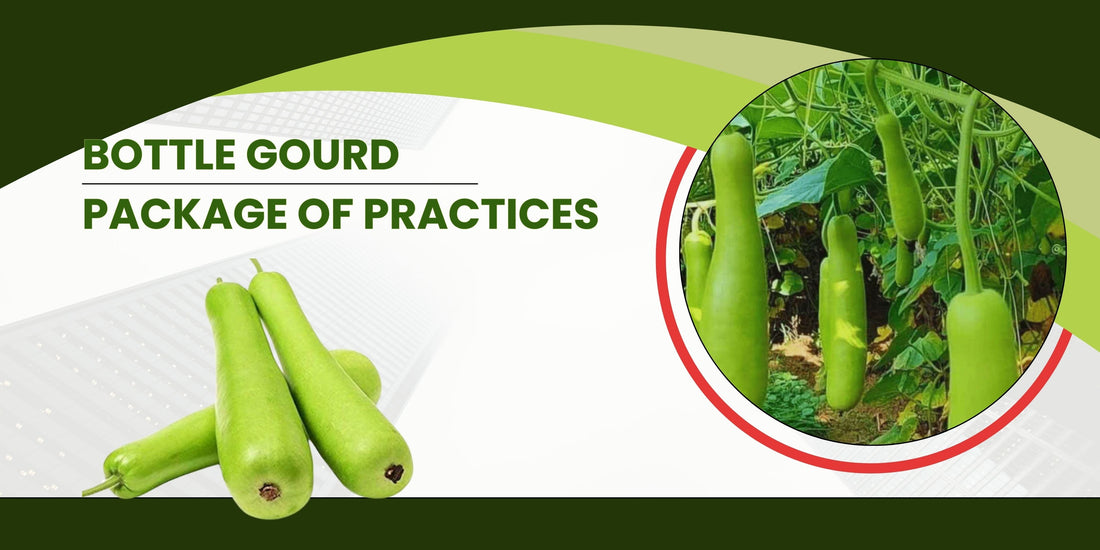
BOTTLE GOURD PACKAGE OF PRACTICES
Scientific name: Lagenaria sicerari
Local name: Sorakaya/Anapakaya
Introduction:
- In India, it is an important vegetable crop.
- In green stage, the vegetables and leaves with stem are used as a vegetable.
- Hard shell of the Bottle Gourd is used for different purposes.
- It is one of the world’s first cultivated plants and it is not grown mainly for food but it is also used as containers.
Soil Requirement:
- It can be grown in a wide range of soils.
- But it grows best in Sandy loamy soils with a good drainage system.
Climate:
- It requires moist and hot climatic conditions for its cultivation.
- The Vegetables cannot withstand frost.
- For 4 months there should be no frost for its better growth.
- The suitable temperature for its cultivation is 20-32°c.
Season:
The best time to plant seeds are Summer and Monsoon.
Land Preparation:
- 6-7 plowings followed by harrowing should be done to bring the soil to fine tilth.
- In soil, pH range should be from 6.5-7.5 for its cultivation.
- For better yield and good quality of vegetable, organic matter or FYM should be added for making the soil rich.
Sowing Time:
- In the plains for monsoon or rainy crops it is sown from June-July and in the hills in April.
- For summer crops, it is sown from January to end of February.
Seed Rate:
Generally for bottle gourd farming the seed rate should be between 3.5 kg- 6kg/ha.
Seed Treatment:
Before sowing, seeds should be treated with 10gms of Pseudomonas fluorescens or 4gms of Trichoderma Viridae or 2gms/kg of Carbendazim seeds.
Spacing:
- Dibbling method is used for sowing vegetable seed at a spacing of 2m to 3 x 1.0m – 1.5m.
- In a pit, generally 2-3 seeds are sown at 2.5cm – 3.0cm depth.
Varieties:
- Arka bahar: Fruits straight without crook neck medium sized each weighing 1.0 kg at marketable stage, light green and shining fruit, yield of 40-50t/ha.
- Pusa naveen: Fruits are cylindrical, straight and free from crooked neck with average weight of 550g.
- Narendra rashmi: Moderately tolerant to pumpkin beetle. Fruits are bottle shaped having shallow neck and average weight 1.0 kg and Yield 30 t/ha.
- Pusa komal: Moderately tolerant to pumpkin beetle. Fruits are bottle shaped having shallow neck and average weight 1.0 kg and Yield 30 t/ha.
Fertilizer Requirement:
-
10 kg of FYM (20ton/ha), mixture of 100gms of NPK 6:2:12 as basal and 10gms of N/pit for 30 days should be applied after sowing.
-
Before the last plowing, application of Azospirillum, Phosphobacteria( 2kg/ha) and Pseudomonas ( 3kg/h) along with 50 kg of Farmyard manure and 100 kg of neem cake is needed.
Irrigation:
-
This crop requires immediate irrigation and is very beneficial in this cultivation.
-
Summer crop requires irrigation at an interval of 3-4 days.
-
Winter crops are irrigated when it is required.
-
Rainy season crops do not require irrigation.
-
Drip irrigation method can also be used as it has many advantages.
Intercultural Operations:
Weeding: Two to three hoeing is given to keep down the weeds during early stages of growth. Training: The vines are trained to spread on bowers made from thin coconut rope and bamboo sticks particularly in rainy season to prevent the fruit from rotting and allowing the vines and foliage for better exposure to light and air.
Weed Management:
Weeds are generally controlled by cultural practices. Herbicides like Diuron @ 1.5 kg/ha and Fluchloralin @ 3 kg/ha have been found effective in checking the weeds.
Plant protection:
1.Fruit Fly (Bactrocera cucurbitae):
This is the most serious pest of cucurbits. The maggots severely damage the young, developing fruits. The adult fly lays eggs under the skin of developing ovaries. The fruits begin to deteriorate when the eggs hatch into maggots that feed inside them. The infested fruits start to rot due to secondary infection of different microorganisms. The incidence of this insect is more common when the humidity is high. Maggots cannot be directly controlled because they are found inside developing fruits.
Control Measures:
- 1. Installation of sex lures @ 15/acre.
- 2. Application of poison bait at fortnightly intervals (20 g of Malathion 50 WP is combined with 500 g of molasses and 20 g of yeast hydrolysate to create the bait. This mixture is combined with 20 L of water for bait spraying and 2 L of water for poison baiting).
- 3. Spraying of Endosulfan or Thiodan @ 6 mL per 4.5 L of water also partially checks the fly incidence.
- 4. The affected fruits should be pinched off and buried in a pit.
- 2.Red Pumpkin Beetle (Aulacophora foveicollis):
- Yellowish red adult beetles flying near the plants feed voraciously on leaf lamina, making irregular holes. The adults mainly prefer young seedlings, especially at cotyledonary leaf stage, and damage at this stage may kill the seedlings. Grubs feed on the roots and plant parts touching the ground.
Control Measures:
- 1. Following clean cultivation.
- 2. Collection and destruction of the adult beetles.
- 3. Deep ploughing of infested fields just after harvesting to kill the grubs in the soil.
- 4. Dusting the crop with 5 per cent Carbaryl.
- 5. Spraying of Dichlorvos 76 EC @ 1 mL/L, or Methomyl 40 SP @ 2 g/L, or Carbaryl @ 0.2 per cent, or NSKE @ 4 per cent.
Disease Management:
- 1.Powdery Mildew (Sphaerotheca fuliginea and Erysiphe cichoracearum):
- This is a fungal disease and becomes very severe in warm,rain-free growing regions. The disease is greatly influenced by age of the host plant, air humidity and temperature.
Symptoms:
Symptoms first appear on leaves and green stems as white to dirty grey circular patches or spots, which later become powdery and enlarge. Severely attacked leaves turn brown and dry, and defoliation may occur. Fruits of the affected plants become undersized and deformed.
Control Measures:
- 1. Collection and burning of the infected crop debris.
- 2. Seed treatment and soil drenching with systemic fungicides provide protection to young seedlings.
- 3. Fortnightly sprays of Carbendazim (0.1 per cent), Karathane (0.5 per cent)have been found effective on bottle gourd.
2.Downy Mildew (Pseudoperonospora cubensis):
The disease is characterized by the appearance of small, water-soaked lesions on the leaves. These spots are angular, yellow and often restricted by veins on upper surface. A purplish downy growth appears on lower side of these spots in moist weather. The disease spreads rapidly, eventually killing the plant through defoliation. The fruits on infected vines are few, small and poor in taste.
Control Measures:
- 1. Following wider plant spacing, crop rotation, field sanitation, proper drainage and avoiding flood irrigation.
- 2. Removal and destruction of infected crop debris.
- 3. Spraying the crop with Ridomil MZ (0.3 per cent), or Dithane M 45 (0.2 per cent),three to four times at 10-day intervals.
Harvesting:
- The crop is ready to harvest in 60-70 days depending upon the variety and season.
- Medium and tender fruits are harvested depending upon the market requirement.
- Fruits should be cut from a sharp knife
- Vegetables should be harvested when they are still green.
Yield:
The expected average yield can be 100-120 quintal/hectare.
